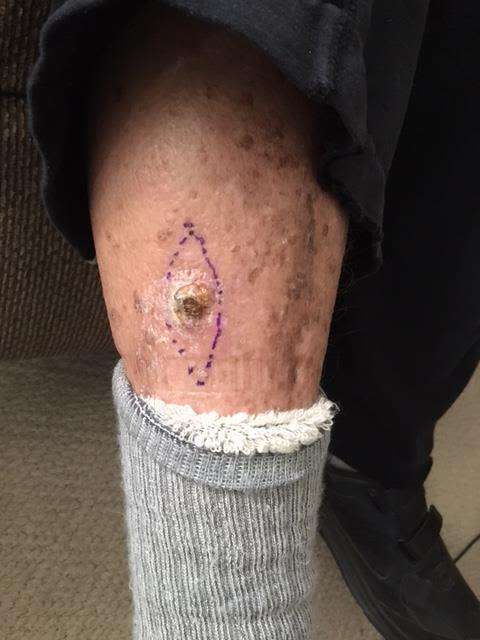How Nodular Melanoma Is Treated
If found early, nodular melanoma can usually be treated and oftentimes cured. However, because of this type of cancers fast-growing nature, it is often only discovered once the condition is advanced.
Nodular melanoma is an aggressive form of skin cancer that grows faster than other kinds of melanoma.
Treatment is focused on curing cancer, preserving skin appearance, and preventing cancer from returning. Treatment options may include surgery, chemotherapy, immunotherapy, radiation therapy, and targeted therapy.
Learn more about the different kinds of treatment for nodular melanoma.
What Is The Life Expectancy For Someone Who Has Been Diagnosed With Melanoma
If you have melanoma, many factors affect your life expectancy. Your age, other medical conditions, and stage of the melanoma are just a few factors. For this reason, its impossible to predict how long one person who has melanoma will live.
What researchers do instead is predict how long a group of people who have melanoma will live. This is called survival rate. If you come across this term while looking for information about melanoma, it is important to know what this means.
Survival rate is the percentage of people who will be alive within a certain time period, such as 5 years, after being diagnosed with a certain stage of melanoma. Each stage of melanoma has its own survival rate.
Before you search for the melanoma survival rates, its important to keep the following facts in mind:
-
Survival rates are estimates.
-
Each person diagnosed with melanoma has unique characteristics, so your outlook may be very different from someone else who has the same stage of melanoma.
-
Newer treatments, such as immunotherapy and targeted therapy, are helping people live longer.
Another important consideration is your self-care after treatment. Protecting your skin from the sun and never tanning can help prevent a new melanoma. Yet, studies reveal that many people continue their old habits after treatment and never protect their skin from the sun.
Finding a new melanoma early can also help.
ImageGetty Images
Melanoma Recurrence Beyond The Original Site
Melanoma recurrences can also result when there is melanoma growth beyond the area originally removed by surgery, sometimes in nearby lymph nodes or other areas of tissue. Melanomas also can be spread by the bloodstream, resulting in new areas of re-growth. If a melanoma is going to recur, it will usually recur within the first two to five years after the original diagnosis and treatment. Patients having a local recurrence are strongly at risk of recurrence elsewhere in the body.
Factors that increase the risk of a recurrence are:
- Thicker original melanomas, especially if located on the head, neck, hands and feet.
- Presence of ulceration in the original melanoma
- Lymph nodes positive for melanoma
Because of the high prevalence of metastasis, patients with local or regional recurrences of melanoma should have a physical examination and and imaging scans of the chest, abdomen and pelvis. The scan will take detailed, cross-sectional images of tissue. The scanning can be with a high-quality CT scan or with a combined PET-CT scan. Johns Hopkins nuclear medicine specialists have studied the application of combined positron emission tomography scanning with CT scanning to detect recurrent melanoma.
Surgery remains the first-line treatment for local and regional recurrences. Lymph node metastasis detected by physical examination or scanning may be treated by complete surgical removal of regional lymph nodes .
Other treatments occasionally appropriate include:
Request an Appointment
Read Also: 2nd Stage Cancer
Treating Stage Ii Melanoma
Wide excision is the standard treatment for stage II melanoma. The width of the margin depends on the thickness and location of the melanoma.
Because the melanoma may have spread to nearby lymph nodes, many doctors recommend a sentinel lymph node biopsy as well. This is an option that you and your doctor should discuss.
If an SLNB is done and does not find cancer cells in the lymph nodes, then no further treatment is needed, although close follow-up is still important.
If the SLNB finds that the sentinel node contains cancer cells, then a lymph node dissection will probably be done at a later date. Another option might be to watch the lymph nodes closely by getting an ultrasound of the nodes every few months.
If the SLNB found cancer, adjuvant treatment with an immune checkpoint inhibitor or targeted therapy drugs might be recommended to try to lower the chance the melanoma will come back. Other drugs or perhaps vaccines might also be options as part of a clinical trial.
What Makes Yale Medicines Approach To Melanoma Unique

Our section’s main focus is skin cancer and melanoma, says Dr. Leffell, who founded this program in 1988 and has also published some of the key research on skin cancer. One great strength of our program is our close working relationship with our skin pathologists. The diagnosis of melanoma is not always black and white, and having the experience to address the nuances is critical for the patient, he says.
Special approaches are used in the treatment of melanoma in situ, and the team at Yale Medicine probably has the most experience in the region treating this type of melanoma.
If the melanoma is more advanced than the earliest stages, or cant be treated in the office setting, we work closely with our colleagues in Yale Medicine’s Departments of Surgical Oncology and Medical Oncology, who assume care of the patient in a seamless fashion, Dr. Leffell notes.
Also Check: Lobular Carcinoma Survival Rate
Treatment Of Stage I Melanoma
For information about the treatments listed below, see the Treatment Option Overview section.
Treatment of stage I melanoma may include the following:
- Surgery to remove the tumor and some of the normaltissue around it. Sometimes lymph node mapping and removal of lymph nodes is also done.
- A clinical trial of new ways to find cancercells in the lymph nodes.
Use our clinical trial search to find NCI-supported cancer clinical trials that are accepting patients. You can search for trials based on the type of cancer, the age of the patient, and where the trials are being done. General information about clinical trials is also available.
Metastatic Or Advanced Skin Cancer
It is uncommon, but non-melanoma skin cancer can spread to another part in the body from where it started. In these situations, doctors call it metastatic cancer. If this happens, it is a good idea to talk with doctors who have experience in treating it. Doctors can have different opinions about the best standard treatment plan. Clinical trials might also be an option. Learn more about getting a second opinion before starting treatment, so you are comfortable with your chosen treatment plan.
Surgery alone cannot always eliminate skin cancer that has metastasized. If cancer cannot be removed with surgery, it is called unresectable. To control distant spread, a persons treatment plan may include chemotherapy, radiation therapy, and/or targeted therapy. Palliative care will also be important to help relieve symptoms and side effects.
Squamous cell carcinoma. Metastatic or unresectable squamous cell carcinoma of the skin is rare, so treatment plans often use the same treatments that have worked in people with squamous cell carcinoma of the head and neck that may not have started on the skin. Chemotherapy usually includes taxanes, such as docetaxel or paclitaxel , and platinums, such as carboplatin or cisplatin . The main side effects of these medicines include fatigue, low blood cell counts, rashes, diarrhea, and changes in sensation in the tips of the fingers or toes. Learn more about the basics of chemotherapy.
You May Like: How Long Does It Take For Melanoma To Spread To Organs
When Melanoma Can’t Be Cured
If your cancer has spread and it is not possible to cure it by surgery, your doctor may still recommend treatment. In this case, treatment may help to relieve symptoms, might make you feel better and may allow you to live longer.
Whether or not you choose to have anti-cancer treatment, symptoms can still be controlled. For example, if you have pain, there are effective treatments for this.
General practitioners, specialists and palliative care teams in hospitals all play important roles in helping people with cancer.
What Is Radiation Therapy
After surgery your doctors may recommend radiation therapy to help improve your outcome.
Radiation therapy uses x-rays to kill cancer cells by damaging their DNA. Normal cells can repair damage to their DNA, but cancer cells are less able to do this and therefore die. The dead cancer cells are then broken down and eliminated by the bodys natural processes.
Since radiation therapy damages normal cells as well as cancer cells, treatment must be carefully planned to allow the normal cells to repair themselves and minimise side effects.
The total dose of radiation and the number of treatments you need will depend on the size and location of your melanoma, your general health and other medical treatments youre receiving.
The radiation used for cancer treatment can come from a machine outside your body or it might come from radioactive material placed in your body near the cancer cells.
Also Check: How Long Does It Take Melanoma To Metastasize
Considering Complementary And Alternative Methods
You may hear about alternative or complementary methods that your doctor hasnt mentioned to treat your cancer or relieve symptoms. These methods can include vitamins, herbs, and special diets, or other methods such as acupuncture or massage, to name a few.
Complementary methods refer to treatments that are used along with your regular medical care. Alternative treatments are used instead of a doctors medical treatment. Although some of these methods might be helpful in relieving symptoms or helping you feel better, many have not been proven to work. Some might even be harmful.
Be sure to talk to your cancer care team about any method you are thinking about using. They can help you learn what is known about the method, which can help you make an informed decision.
Clinical Trials For Melanoma
As part of our commitment to bringing patients new and innovative treatment options for melanoma and other cancers, Cancer Treatment Centers of America® may suggest clinical trials to qualifying patients.
In many cases, clinical trials are intended for patients with advanced cancer, those who have not responded to standard-of-care treatments or patients who may have run out of other treatment options. However, patients may qualify for a clinical trial at any stage of their myeloma and/or treatment.
Talk to your doctor about whether a clinical trial is an option for you and ask about the risks and requirements involved.
You May Like: Stage 2 Melanoma Skin Cancer
Reconstruction Of Your Wound Site
After the melanoma is removed, you may need to have reconstruction on your wound site. Before your surgery, your surgeon will talk with you about what type of reconstruction is right for you. Your surgical team may include a head and neck surgeon as well as a plastic surgeon.
Types of reconstruction
How Is Melanoma Diagnosed

Your doctor will check your skin to look for melanoma. If your doctor thinks that you have melanoma, he or she will remove a sample of tissue from the area around the melanoma. Another doctor, called a pathologist, will look at the tissue to check for cancer cells.
If your biopsy shows melanoma, you may need to have more tests to find out if it has spread to your lymph nodes.
You May Like: Invasive Ductal Carcinoma Grade 3 Survival Rate
Historic Progress New Options More Hope
While melanoma is one of the most dangerous forms of skin cancer, promising new treatment options are improving quality of life and increasing survival rates for patients with advanced melanoma.
If youve been diagnosed, your treatment choices depend on the stage of the disease, the location of the tumor and your overall health. Options include:
New Treatments In Clinical Trials
Clinical trials are currently underway to test new treatments for nodular melanoma. These treatments are not yet available to the public.
One treatment that is currently undergoing clinical trials is vaccine therapy. This involves using certain substances to help stimulate the immune system. Once the vaccine therapy has been administered, the stimulated immune system can then locate and kill tumors in the body.
This treatment is being studied for the treatment of stage 3 melanoma that cant be effectively treated through surgery.
In some cases, participating in a clinical trial may be the best treatment option for a person with cancer. In a clinical trial, a cancer patient may be one of the first to receive a new treatment.
If you have advanced nodular melanoma and are interested in participating in a clinical trial, you should speak with your healthcare team about the options being studied and what might work for you.
You May Like: Idc Breast Cancer Survival Rate
Effective Options For Early Stage Scc
Most squamous cell carcinomas of the skin can be cured when found and treated early. Treatment should happen as soon as possible after diagnosis, since more advanced SCCs of the skin are more difficult to treat and can become dangerous, spreading to local lymph nodes, distant tissues and organs. Find out more about treatment options for advanced or recurring SCCs here.
If youve been diagnosed with an SCC that has not spread, there are several effective treatments that can usually be performed on an outpatient basis. The choices available to you depend on the tumor type, size, location and depth, as well as your age and overall health.
Options include:
Signs Of Melanoma Include A Change In The Way A Mole Or Pigmented Area Looks
These and other signs and symptoms may be caused by melanoma or by other conditions. Check with your doctor if you have any of the following:
- A mole that:
- changes in size, shape, or color.
- has irregular edges or borders.
- is more than one color.
- is asymmetrical .
- itches.
- oozes, bleeds, or is ulcerated .
For pictures and descriptions of common moles and melanoma, see Common Moles, Dysplastic Nevi, and Risk of Melanoma.
Also Check: Grade 3 Cancer Treatment
Can You Die From Skin Cancer On Your Head
Yes. You can die from untreated skin cancer on your head.
However, do not panic yet. Most skin cancer on the head or skin cancer on the scalp is highly treatable, especially during the early stages.
If you are still in the earliest stages of treatment, such as for Stage I melanoma, there is a low risk of metastasis or recurrence.
According to Healthline and other sources, the five-year survival rate for the earliest stages of melanoma on the scalp is as high as 97%.
Recommended Reading: Small Blue Cell Tumor Prognosis
Surgical Removal Of The Melanoma
Treating early melanoma
Stage 0 in situ and stage I
Tumors discovered at an early stage are confined to the upper layers of the skin and have no evidence of spread. These melanomas are treated by excisional surgery. Usually, this is the only treatment required. The first step was a biopsy, where the physician removed part or all of the lesion and sent it to a lab for analysis, where the melanoma was diagnosed and staged. For the excisional surgery, the surgeon removes more tissue from the site.
Melanoma in situ is localized to the outermost layer of skin . Stage I melanoma has invaded the second layer of skin . In both stage 0 and stage I melanoma cases, the physician uses a scalpel to remove any remaining tumor plus a safety margin of surrounding normal tissue. The margin of normal skin removed depends on the thickness and location of the tumor. After surgery the margins are checked to make sure they are cancer-free. If the margins are cancer-free, no further surgery is necessary.
Surgeons may, under certain circumstances, recommend removal of melanoma by Mohs surgery. The procedure is done in stages over a few days to remove all of the cancer cells in layers while sparing healthy tissue and leaving the smallest possible scar. One layer at a time is removed and examined until the margins are cancer-free. New advances in this technique make it easier for the surgeon to spot melanoma cells in the margins.
Treating intermediate, high-risk melanomas
Stage II
Also Check: Invasive Mammary Carcinoma Survival Rate
It Was Official: I Had Melanoma On My Scalp
I remember never feeling nervous about what my biopsy would reveal. Looking back though, I should have been panicked. For someone who felt so confident about life, one cannot imagine how surprised I was to learn two weeks later that I had stage 2 advanced nodular melanoma on my scalp.
Although I had a million questions at the time, I still wasnât concerned. In fact, I remember telling my mom, âNo need to cry. It was just a tiny spot on my head. Donât worry so much.â The next day, everything changed.
Read Also: What Is The Most Aggressive Skin Cancer
Treating Stage 3 Melanoma

If the melanoma has spread to nearby lymph nodes , further surgery may be needed to remove them.
Stage 3 melanoma may be diagnosed by a sentinel node biopsy, or you or a member of your treatment team may have felt a lump in your lymph nodes.
The diagnosis of melanoma is usually confirmed using a needle biopsy .
Removing the affected lymph nodes is done under general anaesthetic.
The procedure, called a lymph node dissection, can disrupt the lymphatic system, leading to a build-up of fluids in your limbs. This is known as lymphoedema.
Cancer Research UK has more information about surgery to remove lymph nodes.
Recommended Reading: Invasive Ductal Carcinoma Breast Cancer Survival Rates